April 3, 2024 | The Public Domain Review | By Thom Sliwowski
Throwing people out of windows (or defenestrating them, as the Latin has it) is an act imbued with longstanding political significance in Prague. From the Hussite revolt in the late Middle Ages through the Thirty Years’ War to modern instances of “autodefenestration”, Thom Sliwowski finds a national shibboleth imbued with ritual efficacy.

It was the spring of 1618 and Matthias, Holy Roman Emperor and past King of Bohemia, had devised a plan that would prove calamitous. Seeking to reverse the concessions granted a decade prior by his brother and predecessor, Rudolf II, he tasked his deputies with reining in the rights of Bohemian Protestants. But these Protestants lived in a tradition of religious dissidence preceding Martin Luther by a century: they were accustomed to a degree of autonomous rule and religious freedom uncommon elsewhere in Habsburg realms. When Matthias’ deputies halted the construction of chapels in Klostergrab and Braunau, Protestants, noblemen, and free burghers found themselves united in their indignation. Ordinarily, these groups had few interests in common. At the time, they could not see — as subsequent historians, painters, and poets would — that they were already becoming Czech, and were about to take part in what, centuries later, would be retrospectively recast as a kind of idiosyncratic national ritual. Nor could Matthias and his advisors see that the Holy Roman Empire was standing before a historical precipice. Keen to meddle in local affairs, Matthias was shrewd enough to act through his zealous deputies. And it was to them that the gravity of this situation would first become apparent.
Two Catholic deputies, Jaroslav Bořita of Martinice and Vilém Slavata of Chlum, had grown notorious for openly disavowing the Majestätsbrief: Rudolf II’s 1609 liberal guarantee of religious tolerance. When a Protestant assembly spurned by the shuttered chapels in Klostergrab and Braunau attracted a massive crowd, Martinice and Slavata began to worry. And when the count Jindřich Matyáš Thurn, elected defender of the Protestant faith, called for their execution, they realized it was already too late. The Catholic deputies had overplayed their hand; the mood among the infuriated townspeople was rising to a fever pitch. A large crowd followed the Protestant nobles to Hradčany Castle. They poured inside and to the upper floors, cornering Martinice and Slavata in a tower chamber. Shouting at, threatening, and then grabbing the deputies, they chucked Martinice out the window first. Slavata, meanwhile, held onto the ledge, begging for the Virgin’s intercession. In one final push, the crowd expelled him from the castle window as well. Only the deputies’ secretary remained. Shaking with fear, he clung to the prominent Protestant nobleman Joachim von Schlick for protection, but the defenestrators, as they would come to be called, peeled him off Schlick and tossed him out the window too.
Exuberant, the Protestant rebels mocked these appeals to the Virgin Mary. But when two of them leaned out the window to heap more insults down upon their oppressors, what they saw left them flummoxed. Martinice and Slavata were alive, as was their secretary, and the three were already getting up to reach for a ladder extended by allies from a lower window in the castle. How the Catholic deputies survived this forty-foot fall was a mystery that has turned the defenestration into an object lesson in framing. Catholic propagandists insisted that the Virgin Mary had saved them: Slavata’s prayer for intercession worked, effecting a miracle that legitimated their cause. Protestant pamphleteers, on the other hand, noted that a pile of trash and human shit directly below the window had broken their fall. They may have survived, but only to remind others how loathsome was their attempt to quash local rights.1
Words seem inadequate to the task of describing something so outlandish, and yet “defenestration” comes close. This word is grammatically a compound nominalization — and a flagrantly Latinate one at that. “Fenestrate”, the verb ostensibly at its root, only appears a couple centuries later, carrying two unrelated technical usages in the fields of surgery and botany. From this we can surmise that “defenestration” was a linguistic artifact constructed intentionally. Perhaps it meant to lampoon the Latin of Bohemia’s Catholic rulers: in Czech it is simply “defenestrace”, a rare Latinate word in that language. The humor here derives from the fact that a form of free fall carries a name as clunky as the doctrines and mores of the Catholic rule it sought to swiftly overturn.
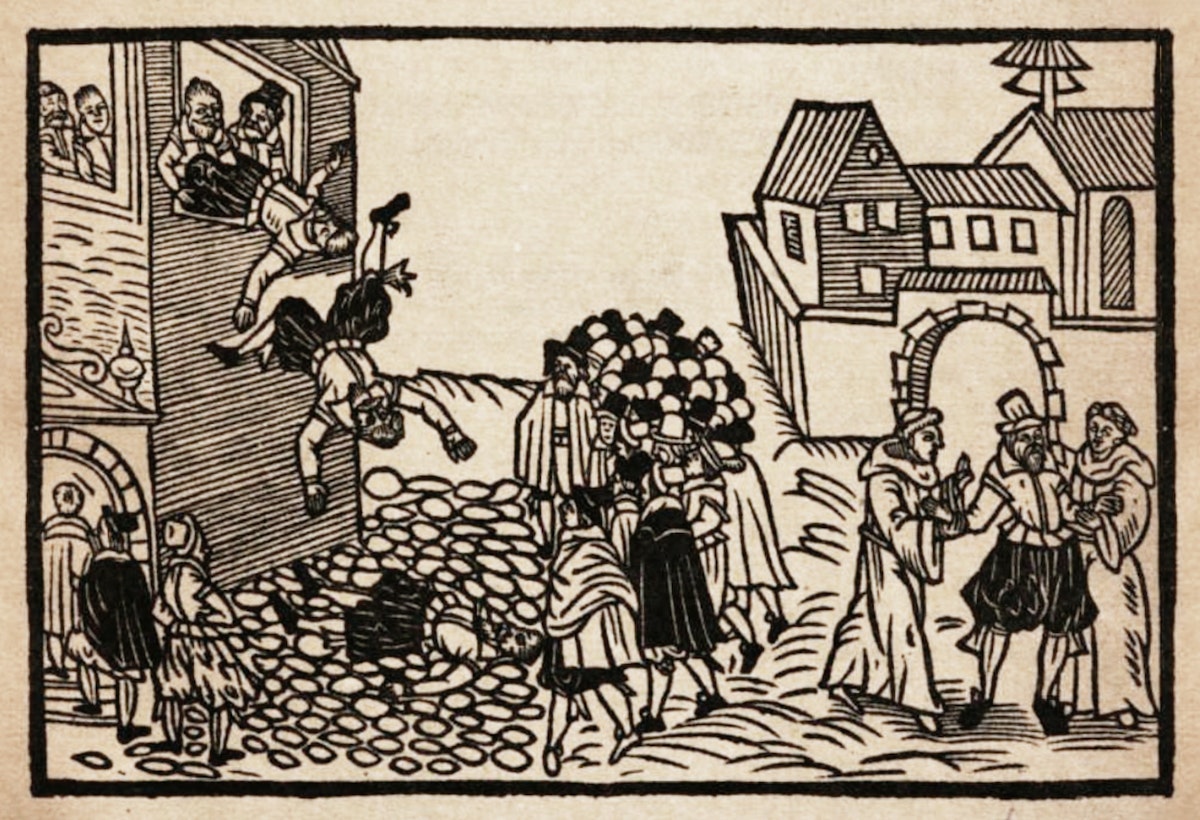
Almost immediately, the task of illustrating the defenestration became paramount. A 1618 Catholic Flugblatt (or pamphlet) depicts Martinice and Slavata falling onto a courtyard paved with stones. An accompanying caption renders the event as legend: thanks to the Virgin’s intercession, the deputies’ lives were saved and they took refuge in a nearby cloister. Foolhardy political revolt is here transfigured into a leap of faith that furnishes its own proof: they were, after all, still alive when this image was printed. Regrettably, opposing Protestant pamphlets, depicting the pile of excrement that broke their fall, are harder to come by.
Miracle or mere coincidence, the defenestration catalyzed a broader Bohemian uprising: the first eruption of what would become the Thirty Years’ War. News of the Prague defenestration traveled across Europe within the year; its images proliferated in contemporary pamphlets, fliers, and compendia of recent events. Centuries later, the act of defenestration would serve as a touchstone of Czech national identity and of Prague’s municipal history. But first it would be represented and re-invoked so many times that this concrete, historical event gradually became abstracted into a figure of thought.
We find the seeds of this abstraction in an engraving that was printed in the Theatrum Europaeum: a German historical chronicle published by Matthäus Merian in the mid-seventeenth century. Here, partisan framings are eschewed in favor of neutral representation. Within the castle, men are hoisting the Catholic deputies to the windowsills while their secretary awaits his turn in the center of the image. The focus on him as the engraving’s central figure suggests the perennial question that haunts all news about violent revolts: who will be next?
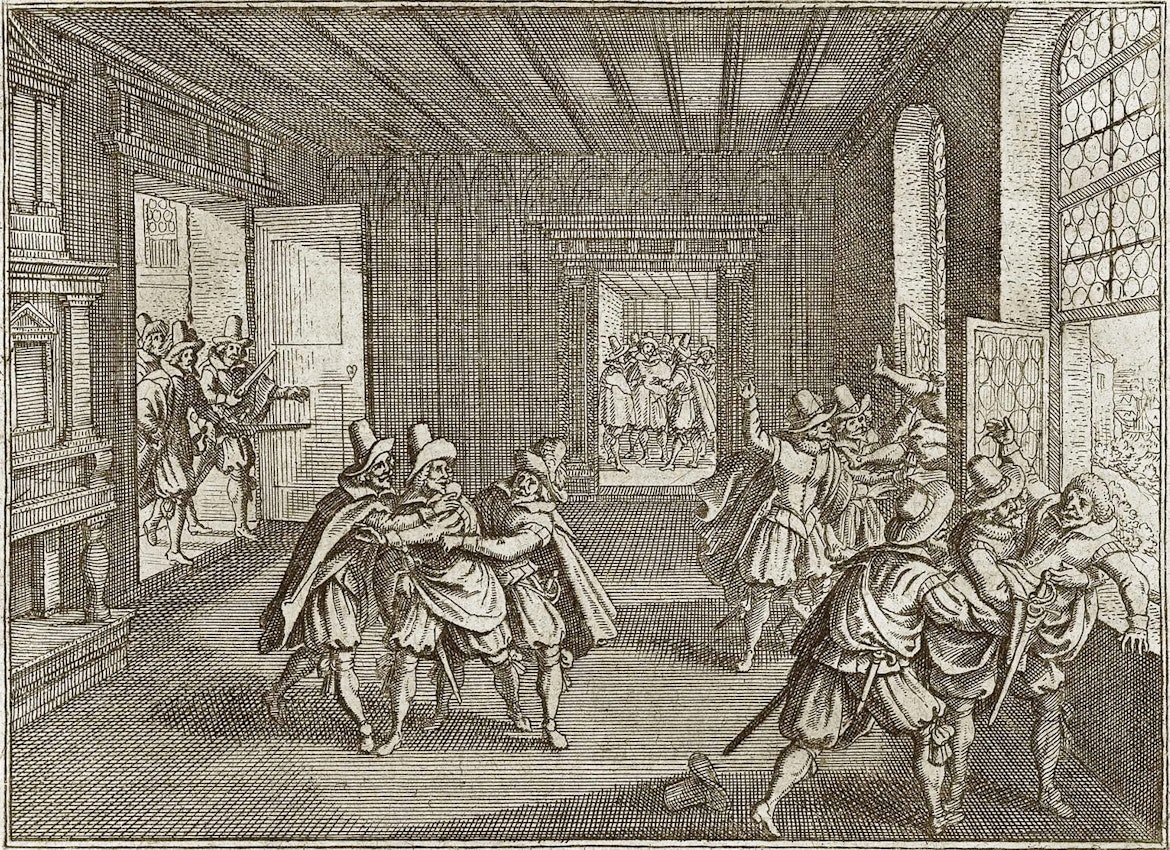
Of course, the 1618 defenestration would not be the last one to take place in Prague — but neither was it the first. Two centuries earlier, Jan Hus, a wildly popular theologian, inveighed against the Church, denouncing its political authority and its system of monetary indulgences. He also called for Mass to be celebrated not in Latin but in the local tongue, which was then named Bohemian but which we would now call Czech. To this end, Hus wrote his Orthografia Bohemica (1406–1412): the first dictionary of the Czech language, in which he invented the haček and the vowel-length markers, which make Czech spelling unique among European languages. This religious reformer and fervent grammarian was subsequently arrested, found guilty of heresy, and burned at the stake in 1415. By making him into a martyr, the Church had all but guaranteed Hus’ legacy.2 And his followers cemented this legacy by revolting. In 1419, they stormed the Novoměstská radnice, Prague’s “New Town Hall”, and threw three municipal consuls and seven citizens out of a window.
With this violent spectacle, Hus’ followers, who would come to be known as Hussites, won the right to rule themselves and to worship as they chose. They retained this right until 1483, when King Vladislaus II stormed Prague and reestablished Catholic rule. Another defenestration followed, as these proto-Protestants tossed the Burgomeister and the corpses of seven town counselors out of various halls across the city. Again the spectacle worked: a religious reconciliation at the 1485 Peace of Kutná Hora established the Hussite and Roman Catholic faiths as equal before the law. Were the two defenestrations that opened and closed the Hussite Wars decisive for their outcome, or merely incidental? One could be forgiven for thinking that the act of defenestration, as violent as it is theatrical, seemed to carry some magical efficacy.
A compelling ritual is one thing, but lasting historical efficacy is something else entirely. The Bohemian Revolt that followed the 1618 defenestration was decisively suppressed only two years later, in a battle on the outskirts of Prague between the Bohemian Confederation and the Holy Roman Empire. The 1620 Battle of White Mountain slammed shut the window of possibility for Czech self-determination, inaugurating a period of harsh Germanization lasting almost two centuries. Germanophone Catholic agents of the Empire suppressed the language and burned Czech books, under the pretext of a Counter-Reformation strategy aimed at stamping out the Hussite confession once and for all.
No surprise, then, that when the Czech National Revival broke out in the early nineteenth century, it was led largely by radical lexicographers and philologists. Josef Dobrovský published a Czech grammar in 1809, and Josef Jungmann a five-volume Czech-German dictionary over the years 1834–1839.3 Together the two Josefs set down the medium in which Czech culture could flourish: poetry, painting, and history writing — all fueled by the heady currents of Romanticism — elaborated Czech-ness, making a nation out of the language’s speakers. The wave crested in 1848 with the eruption of the June Revolution in Prague. But this uprising, too, eventually failed.
The most enduring artifact of the Czech National Revival was a sense of historical consciousness that recast the Prague defenestrations as national revolts avant la lettre. Aberrant curios no longer, the early modern defenestrations found new life as links in a chain that led directly to the 1848 Spring of Nations. The visual archive from the nineteenth century appears like an anchor line plunging into the abyss of the past. It is here we find the earliest depictions of the fifteenth-century Hussite defenestrations, such as an engraving from the Česko-Moravská Kronika of 1872. Written by Karel Vladislav Zap, a writer and pedagogue best known for popularizing Czech history, this book aimed to instruct the Czechs about who they were. Defenestration came to be at this point a national shibboleth: because they had thrown their enemies from castle windows, the reasoning seems to go, these Hussite rebels were, in fact, ancestors of the nationalists that we are today. To be Czech meant not only to speak the language, but also to be aware of defenestration’s significance.
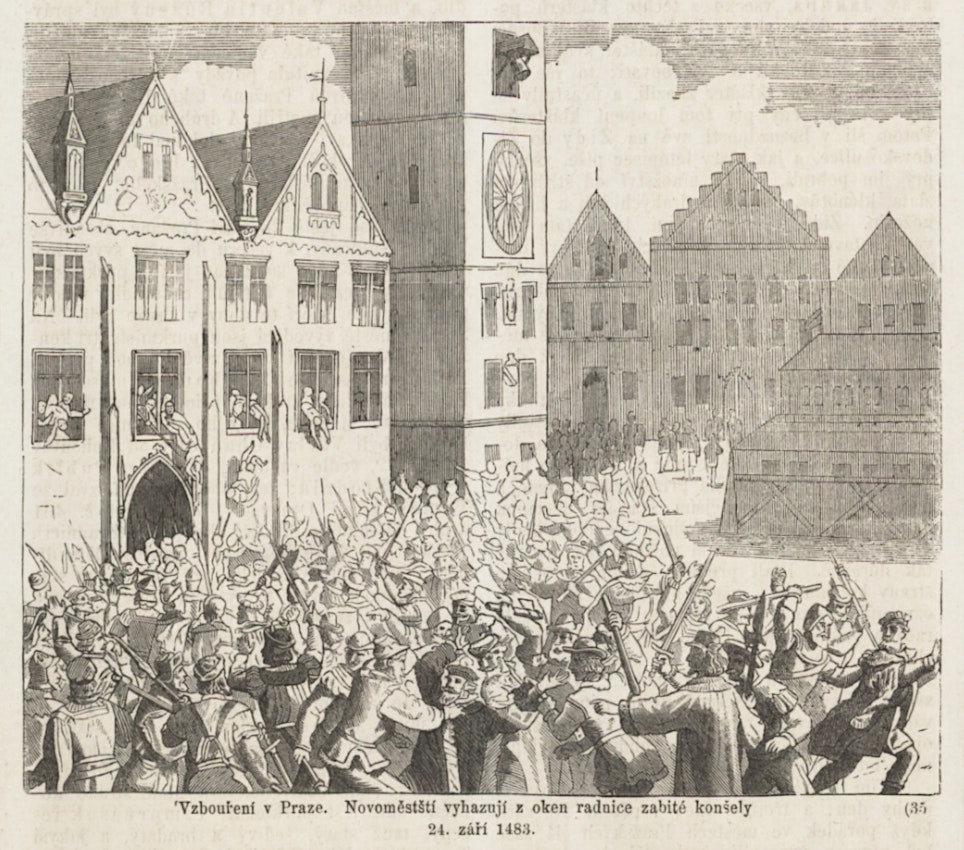
More than any other defenestration, it was the 1618 instance that captured the imagination of Romantic revolutionaries agitating for the Czech cause. A somewhat earlier painting, from 1844 by Karel Svoboda, stages this defenestration with all the trappings of the nineteenth-century Czech National Revival. Open books and reams of paper litter the left foreground, invoking the work of the lexicographers who codified the language. A toppled chair suggests authority overturned — a motif that later painters will repeat — and the open window looks to be smashed in a curious way. Though this is a historical painting, its call to revolutionary violence is rendered here in the present tense.
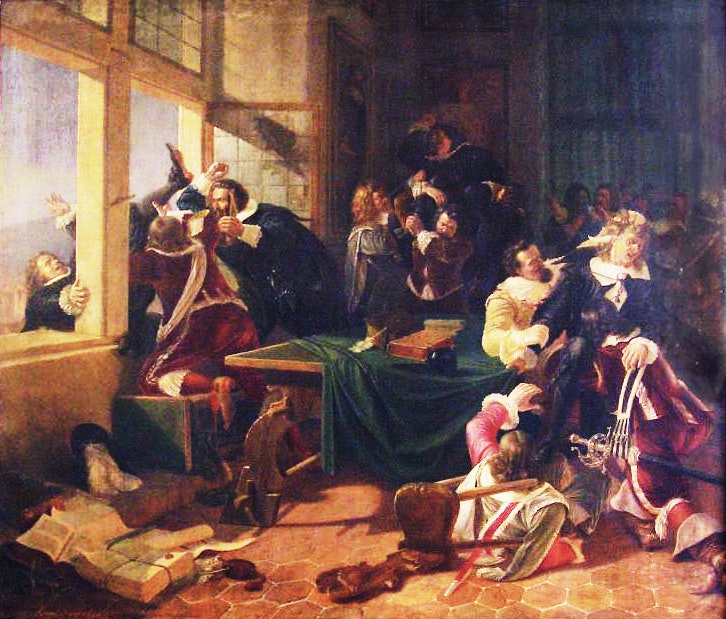
Depictions like these elevated and abstracted the historical event of defenestration into something more significant than a milestone. Historical change might be called a “watershed” or a “turning point”, but certain events forge their own metaphors. The 1789 Storming of the Bastille evokes the tumult of the French Revolution, and the 1989 Fall of communism suggests the collapse of a system that turned out to be remarkably flimsy. “Defenestration” does something similar: for nineteenth-century Czech nationalists, these events (and how they model historical change) took on a poetic significance. Some historians surmise that the 1618 Protestant crowd was deliberately reenacting the earlier defenestrations; Czech nationalists certainly thought so, placing the Hussite and Protestant defenestrations in a line of succession that became a tradition and a figure for thinking about history.4
The apogee of painterly depictions of the 1618 event came a half-century later, in two paintings by Václav Brožík from 1890 and 1891. In the first, Pražská defenestrace roku 1618, the line of action moves leftward as the dynamic image expresses the eruption of affect that, for Brožík, defines this act. Martinice is halfway out the window while Slavata, stupefied, is being dragged the same direction. Their secretary is pinned to the desk among some papers, while in the foreground, under the window, lies a toppled chair. A throne overthrown, this chair perhaps embodies the anti-monarchic energy that nineteenth-century nationalists ascribed to the Protestant rebels fighting for political autonomy. The energy in this painting implies hydraulic forces at work: it is as if the upswell of revolutionary emotion tends naturally, automatically to the window, which is at once a release valve and an opening onto the future. If to look out a window is to imagine political possibility — the painting seems to say — then to throw somebody out a window is to make history happen.
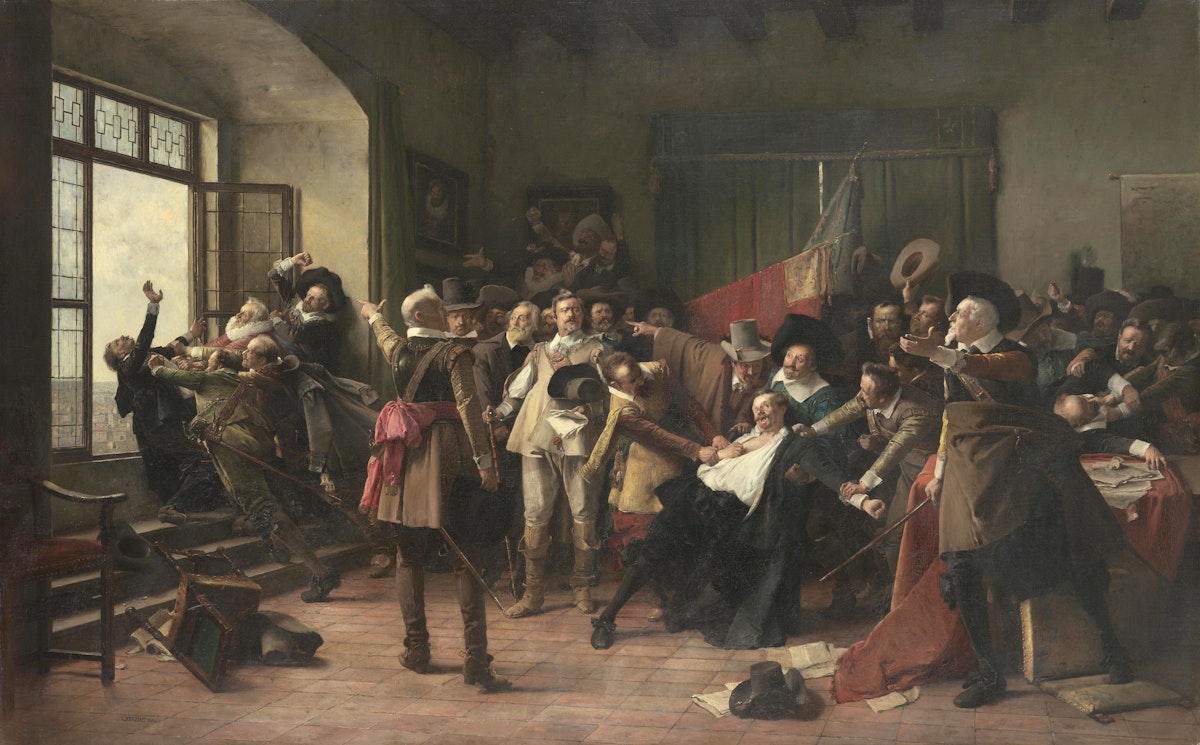
Brožík’s 1891 painting depicts the defenestration’s aftermath, showing how even the most ardent collective revolts can be stymied. In the adjacent room, exhausted on a chair, one of the escaped Catholic deputies recovers from their terrifying ordeal: miraculous or odious, the defenestration they survived nevertheless shook them to their cores. Among the crowd one finds some characters from the previous painting, including Count Jindřich Matyáš Thurn, in red. This crowd is kept at bay by the Princess Polyxena of Lobkowitz, a politically-active figure who played a significant role in the Bohemian Counter-Reformation. All the way to the right, an empty chair with a scepter laid atop it invokes monarchical authority preserved. Princess Polyxena single-handedly stands between the Protestant rebels and the accomplishment of their task, representing the forces that stood in the way of Bohemian self-determination and Czech national consciousness. However, by placing her at the center of the painting — and in this powerful pose: index finger pointing downward, face stern — Brožík created a far more ambiguous scene. Here, at least, it could go both ways: perhaps Polyxena was right to protect these artifacts of divine intercession.
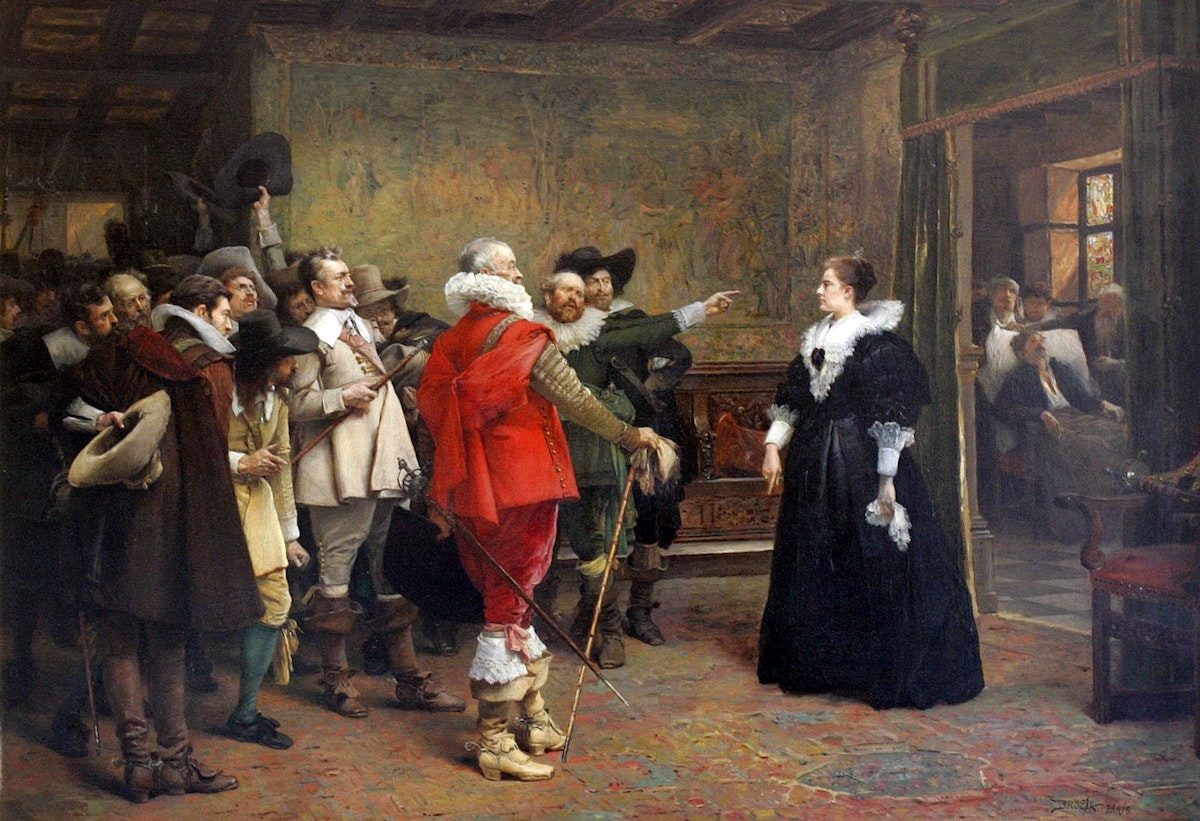
Already a figure for representing historical change, defenestration became the emblem of a uniquely Czech form of fatalism during the twentieth century. Writers took it up, elaborating and unfolding its significance, and made this idea into an object of obsession. The word’s curious meaning in this century is the strange son of its nineteenth-century usage: to grasp its significance we must briefly retrace its paternity.
Of all the heroes of the Czech national cause, none looms larger than Tomáš Garrigue Masaryk. Born into a working-class Moravian family, he pursued philosophy in Vienna and Leipzig, studying under Franz Brentano and Edmund Husserl. He wrote a habilitation thesis on the sociology of suicide: a topic that would prove eerily prescient. A scientific and progressive thinker, he married the American Charlotte Garrigue after meeting her in Leipzig, taking her surname as his second name. In 1918, after a lifetime spent championing the Czech cause, including during speeches given at the Treaty of Versailles, Tomáš Masaryk found himself elected president of the newly independent Czechoslovakia.
Masaryk served as a widely beloved president until his death in 1935. Three years later, Hitler’s Third Reich would annex the Sudetenland: those border-regions of interwar Czechoslovakia inhabited mostly by ethnic Germans. So began the Second World War in Bohemia. If the 1618 defenestration spurred the Thirty Years’ War, what came to be known as the Fourth Defenestration of Prague concluded this one. The beginning of the end was heralded by the Soviet liberation of Prague in 1945. The Czech and Slovak Communist Parties, already popular in the 1946 elections, staged a coup d’état in February of 1948. They had reason to eliminate their opponents, and they soon set their sights on Czechoslovakia’s foreign minister, Jan Masaryk.
The son of Tomáš Masaryk, Jan had served as minister plenipotentiary for the new nation in London since 1925. In 1940, with his country swallowed up by the Third Reich, he was appointed foreign minister of the Czechoslovak government in exile. A reluctant supporter of Stalin, he traveled to Moscow in April, 1945, to agree on Czechoslovakia’s foreign policy. (He had signed a twenty-five-year alliance with the Soviet leader two years prior.) With increasing disappointment, he observed the postwar developments in Prague until, on March 10, 1948, Masaryk was found dead in the courtyard of the foreign ministry wearing only his pajamas. He had fallen from his bathroom window. The official cause of death was listed as suicide, but in the popular imagination this event came to be called the Fourth Defenestration of Prague.
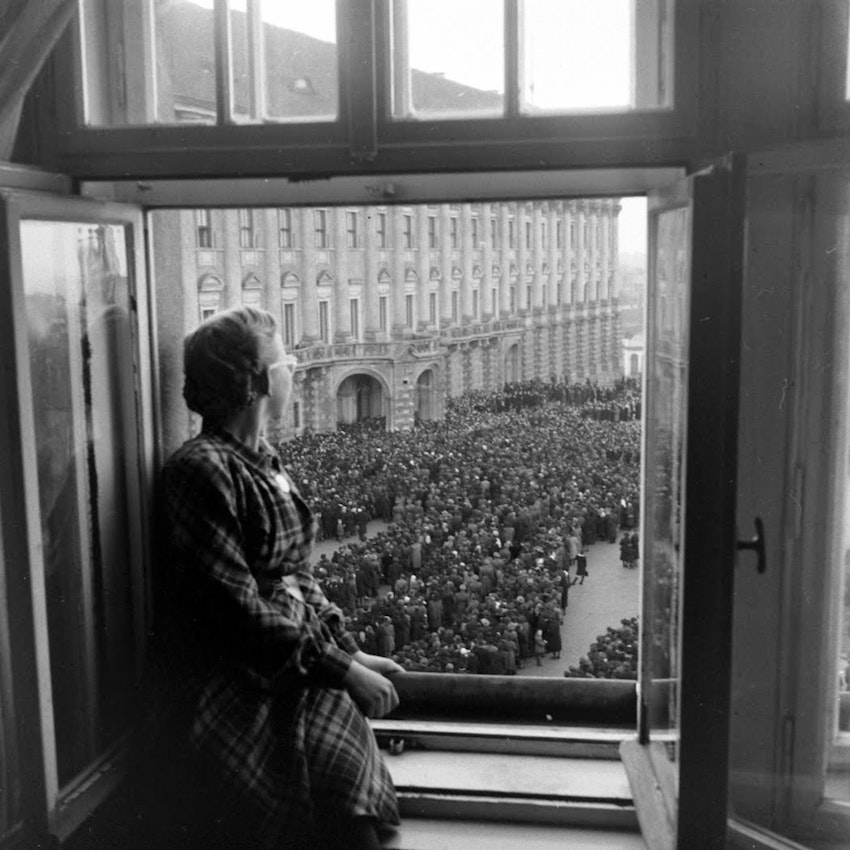
The Czechoslovak authorities were quick to wrap up their investigation into Masaryk’s death, having determined that it was a suicide. But the case would be reopened, incredibly enough, half a century later. In 2004, the Prague Police enlisted forensic expert Jiři Straus to reexamine the evidence, and Straus found that Masaryk, “a heavy[set] man and certainly no athlete . . . would have landed much closer to the building if he had jumped.”5 Because he had fallen so far away from the Foreign Ministry, he must have been pushed. This official finding confirmed what most Czechs had already suspected: no suicide, Masaryk had been murdered on Stalin’s orders.
While defenestrations both real and suggested continued to proliferate throughout the twentieth century after Masaryk’s death, many of them carry a dubious, autotelic quality: writers would pine to be defenestrated, but their desire comes to undo the act’s ritual efficacy. Can defenestration occur without the element of surprise, or without political rivals to carry it out? Is it possible to autodefenestrate? By fixating on the window, writers sprung the frames of what we could call traditional defenestration.
In a recently published academic journal article on the subject, Hana Pichova counted in Kafka’s notebooks at least ten instances of “falling, jumping, or being forcibly thrown from windows”, adding that though such “thoughts occupied the writer more than fleetingly”, they only occupied him so long as he remained in Prague.6 Bohumil Hrabal, the pilsner-drinking bard of postwar Prague, was fixated enough on open windows and falling out of them that he wrote, in the spring of 1989, a text enigmatically entitled “The Magic Flute”, in which he assembles his own compendium of historical and literary defenestrations. This was far from the first time he wrote about defenestration, but never had he mustered such depressive pathos. The text meditates on the stymied protests in Prague, on the self-immolation of the student Jan Palach, and on the hopelessness of existence under the communist order, which would incidentally collapse just six months later.
Hrabal mentions the early twentieth century poet Konstantin Biebl, who “jumped out of the window, but [who] first, and this was a long time before, . . . had Štyrský paint him a picture, of a man falling backwards out of a window, just like turning the page of a book.”7 This painting has unfortunately been lost to history, but Hrabal’s description of it prefigures his own end. Eight years later, in 1997, while in a hospital, Hrabal leaned out his window far enough to plummet to his death. He had said over the days prior that he really wanted to feed the pigeons. Could it be said that his obsession with defenestration was what killed him?
It is almost as if, by the twentieth century, the collective attention accorded to defenestration wound the coils of reason too tightly: in becoming an object of literary fixation, it came to occasion a kind of melancholy rumination, one that eats the fruit it bears for the mind. Already a violent form of political murder, the act took on a character even darker and more sinister. Nevertheless, retracing its history reveals a trajectory at least as astounding as the competing claims of Protestant and Catholic pamphleteers after 1618. Here we have concrete historical events that congeal first into an evocative image, then into a figure of thought for historical change in the Czech style, and finally into a style of suicide. But maybe it is simply a trick of historical perspective that makes it possible to excavate defenestration in this way: the early modern defenestrators were probably not reenacting anything, nor were nineteenth-century Romantic painters necessarily aware that they were instantiating a metaphor for historical shifts. There is something off-putting, even suffocating about trying to concoct a grand theory of defenestration. One is compelled to throw open the window, let in some fresh air, perhaps lean out to get a better look . . .
Notes
- This historical account I take from C.V. Wedgwood’s The Thirty Years War (New York: New York Review Books Classics, 2005).
- His lovable charm is imprinted in his very name, which in Czech means “goose”.
- James Naughton, “Czech Literature, 1774 TO 1918” (2002). Available here.
- See Stephen Jay Gould, “This View of Life: The Diet of Worms and the Defenestrations of Prague”, Natural History 9 (1996).
- Rob Cameron, “Police close case on 1948 death of Jan Masaryk – murder, not suicide”, Radio Prague International (June 1, 2004). Available here.
- Hana Pichova, “‘The Magic Flute’ as an Ode to Defenestration: On the Twentieth Anniversary of Bohumil Hrabal’s Death”, in Slavic and East European Journal, vol. 61, no. 2 (Summer 2017): 331–42.
- Bohumil Hrabal, “The Magic Flute”, in Total Fears: Selected Letters to Dubenka, trans. James Naughton (Prague: Twisted Spoon Press, 1998), 9–22.
Thom Sliwowski holds a PhD in comparative literature and critical theory from UC Berkeley. He writes about history, Eastern Europe, and the body, and his work has appeared in the Los Angeles Review of Books and in Sidecar. He lives in Berlin.

